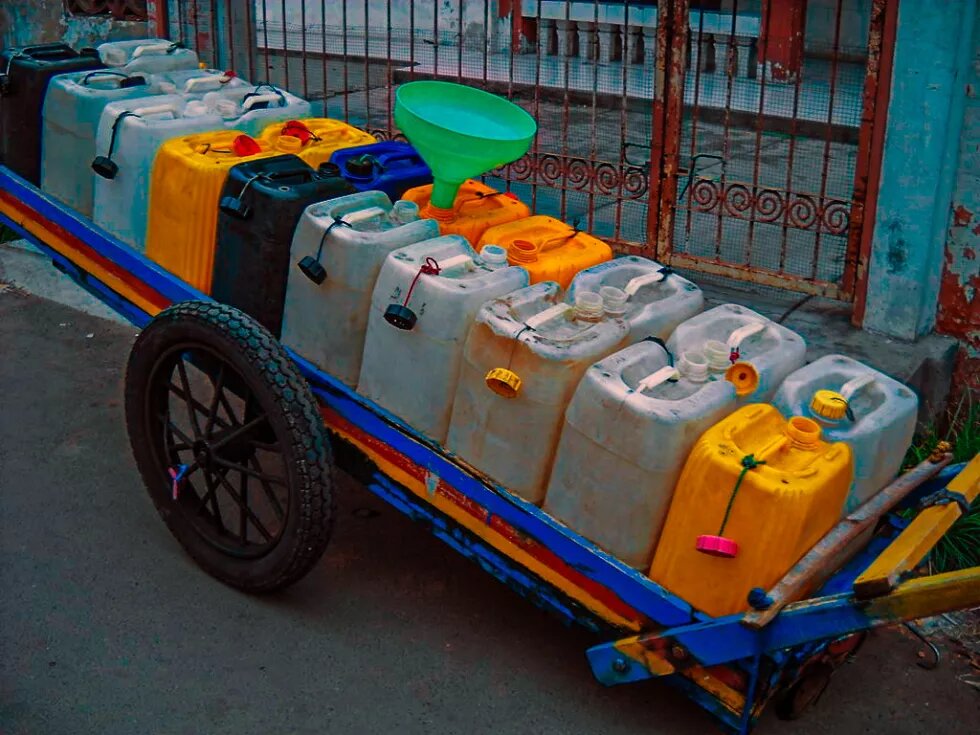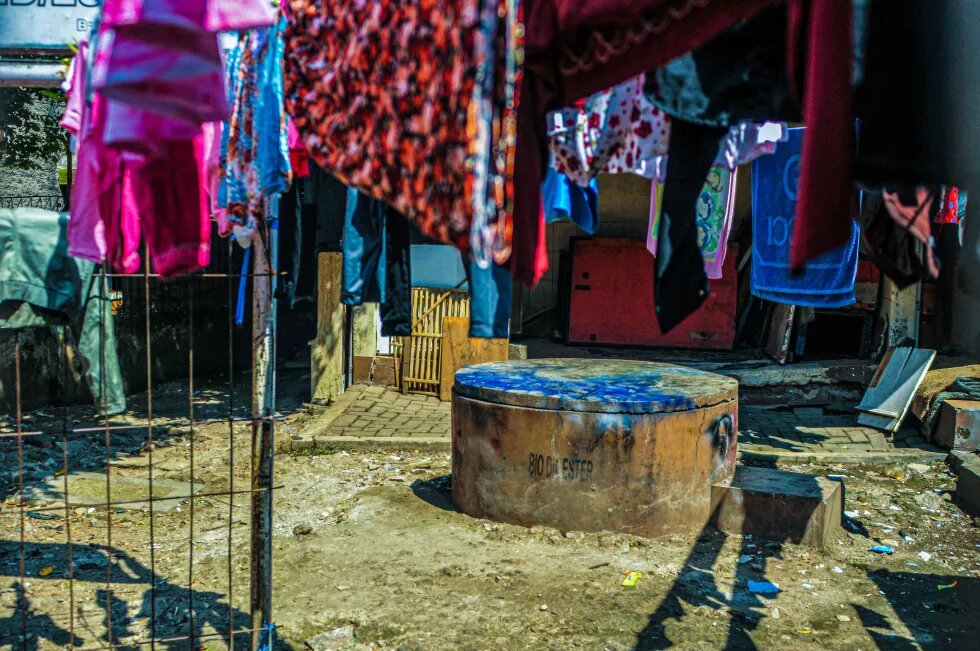
This article explores the challenges and sustainability dilemma of groundwater as the ‘ungoverned’ urban commons with examples from Indonesia.

Jamal, a seasonal labour living in the fringe of Bandung City, Indonesia, had longed to own a private borehole to save him from the daily struggle for water. Every time he managed to save some money, he hired his neighbour, a local contractor, to drill a borehole gradually. In his neighbourhood, people have to drill at least 40 meters deep to gain access to groundwater. Even after Jamal finally completed the drilling, he had to buy an electrical pump to abstract water and a container to store water for daily uses temporarily. As he found out that the water he extracted from his borehole suffers from poor quality, he has been saving to further install a household water filter. Despite the water quality problems, at least he now finally owned a private borehole, and he did not have to resort to contaminated dug wells or expensive water from the cart vendors.
For Jamal, as for almost other two billion people worldwide[1], groundwater is vital to daily survival. Indonesians use groundwater thirty times more than surface water[2]. The 2020-2024 Mid-term National Development Plan states that piped water will cover only 30.45% of the total population[3], signaling that most residential water needs will be met by non-piped sources, mainly groundwater. Groundwater has also been subject to withdrawal by the commercial and industrial sectors in Indonesia. A study in Semarang, Central Java, recorded a high preference for industries to utilize groundwater, driven by inadequate municipal water service and the perception that groundwater is cheaper and easier to access[4]. Despite this high preference, most industries surveyed could not produce extraction permit documents or implement conservation measures.
A 2014 Nature article warns of the global groundwater crisis, in which important aquifers in arid and semi-arid regions, including China, Australia, the Sahara, the Americas, and India, are rapidly depleting[5]. Climate change worsens this situation by increasing catastrophic droughts and heat[6],[7]. Excessive groundwater extraction causes significant ecological and socio-economic impacts, including saltwater intrusion in coastal cities, permanent loss of storage, falling groundwater table, and land subsidence[8]. The last two impacts have been observed in Indonesian cities. For example, the annual groundwater extraction in Bandung Basin is 262.5 million m3. With this rate of extraction, the groundwater table in Bandung Basin had decreased from less than 3 meters below ground level in the 1960s to 10 to 20 meters in 2009[9]. Moreover, the land surface is falling by 5 - 20 cm in Bandung City alone[10], which may further affect soil stability[11]. As a result of this exploitation, it is indicated that numerous groundwater reserves in Indonesia have degraded to critical levels[12]. The impacts of the groundwater crisis will be particularly felt by the most vulnerable: people with low economic power that depend on their water needs from this resource.
Groundwater overexploitation and degradation have been linked to public policies that tend to lean over economic interest over the imperative of universal access to water and the absence of strong regulatory enforcement[13]. The (mis)management of groundwater as an open-access common property is a typical illustration of Hardin's Tragedy of the Commons: everyone is incentivized to extract as much water as is privately profitable without thinking about the long-term consequences of excessive abstraction[14]. The two paradoxical natures of groundwater as urban commons put severe challenges in its management: the openness and the invisibility of groundwater. The openness of groundwater makes everyone with economic power can access this resource, rendering it difficult to restrict, monitor, and enforce regulations. On the other hand, the invisible nature of this resource also makes it also challenging to precisely account for the actual number of users and the extracted amount, thus posing similar challenges in the regulation, monitoring, measurement, documentation, and enforcement. Stone (1997) argues that current resource governance tends to rely on something that can be measured quantitatively; where if a resource is invisible, and therefore, difficult to measure, then the resource is extremely challenging to be managed[15]. This invisibility has led to different perceptions of the 'crisis' narrative in groundwater management and, thus, the efforts exerted by various actors in utilizing and managing groundwater. The openness and the invisibility of groundwater in urban areas render this resource somewhat ‘ungoverned’, where State has limited authority over allocation and management, giving rise to overexploitation and resource degradation[16].
Not only deterioration of the resource, ‘ungoverned’ groundwater also results in differentiated access. A survey in Cikapundung, Bandung City, suggests that borehole ownership is mostly concentrated on respondents belong in higher income classes. In contrast, the use of shallow wells is prominent among households in the lowest income class[17]. Having secured access to sufficient and good quality water depends on individual economic power to finance a private borehole, and its supportive infrastructures, such as plumbing fixtures, water containers, water filters, an electrical pump, and electricity bills for pump operations. Those who cannot afford a private borehole resort to shallow wells, in which seasonal quality and quantity are often threatened.
In light of the gravity of the groundwater problems in urban areas, sociotechnical and institutional innovations on allocating, managing, and governing groundwater are urgent. Several key future research areas in the Indonesian context were identified: How are scholars, State agents, civil society, groundwater narrate the groundwater crisis? How do these narratives lead to contestations in urban groundwater regimes? Can we develop topographies of (in)equity in urban basins and the sociotechnical, political, and economic aspects affecting them? What are the experiences and case studies of knowledge, socio-technical, organisational, and institutional innovations in inclusive and socially-just groundwater management? These key research areas call for interdisciplinary scholars to dive deep into the problem of urban groundwater (mis)management to contribute to achieving universal access to sustainable water for all and preserving groundwater resources.
Acknowledgement: This article is a reflection from a Deep Dive event, “Governing water(s) as a common: Innovative experiences of coproduction in Southeast Asia”, which was held in 26 – 27 October 2022, in Chulalongkorn University, Bangkok, Thailand. The author thanks Frans Tarmedi (Heinrich Böll Stiftung Southeast Asia Regional Office), Nur Novilina Arifianingsih (ITB), and Arief Sutadian (Regional R&D Agency of West Java).
__
Anindrya Nastiti is Assistant Professor, and Researcher of Environmental Engineering at the Faculty of Civil and Environmental Engineering, Institut Teknologi Bandung, Indonesia. Her research interests are in the intersection between environmental engineering, psychology, and sociology. She has been involved in many research projects on WASH (Water, Sanitation, and Hygiene), water governance, risk perceptions, and pro-environmental behaviour.
The views expressed by the author are not necessarily those of Heinrich Böll Stiftung.
References
[1] Müller, M. F., Müller‐Itten, M. C., & Gorelick, S. M. (2017). How Jordan and Saudi Arabia are avoiding a tragedy of the commons over shared groundwater. Water Resources Research, 53(7), 5451-5468.
[2] National Statistical Office (2020). https://www.bps.go.id/publication/2020/12/31/68cf1c94411883822b83952f/indikator-perumahan-dan-kesehatan-lingkungan-2020.html
[3] Presidential Regulation (PERPRES) concerning the 2020-2024 National Medium Term Development Plan https://peraturan.bpk.go.id/Home/Details/131386/perpres-no-18-tahun-2020
[4] Volentino, D. (2013). Kajian Pengawasan Pemanfaatan Sumberdaya Air Tanah di Kawasan Industri Kota Semarang. Jurnal Wilayah Dan Lingkungan, 1(3), 265-274. https://ejournal2.undip.ac.id/index.php/jwl/article/download/140/pdf
[5] Famiglietti, J. S. (2014). The global groundwater crisis. Nature Climate Change, 4(11), 945-948. https://idp.nature.com/authorize/casa?redirect_uri=https://www.nature.com/articles/nclimate2425&casa_token=zOKPZ2Jx7kQAAAAA:RXT36YelPxL0GGXIJGZr3Cp5f90fkS-8r7YpSqAfT89qWXTM-YniGT80wE35uzsWCt-H98DW54lIN5TWbQ
[6] Kumar, C. P.. (2012). Climate Change and Its Impact on Groundwater Resources. Research Inventy: International Journal of Engineering and Science. 1. 43-60. https://www.researchgate.net/publication/253650444_Climate_Change_and_Its_Impact_on_Groundwater_Resources
[7] Kusangaya, S., Warburton, M., Archer, E. R., & Jewitt, G. (2013). Impacts of climate change on water resources in Southern Africa: A Review. http://hdl.handle.net/10204/7382
[8] Rudestam, K., Langridge, R., & Brown, A. (2015). “The commons” as a dynamic variable in understanding strategic alliances of scale: A groundwater case study in Pajaro Valley, California. Environmental Science & Policy, 52, 33-40. https://www.sciencedirect.com/science/article/pii/S1462901115001008
[9] Harnandi, D. dan Herawan, W. (2009). Pemulihan Air Tanah Berdasarkan Kajian Hidrogeologi di Cekungan Air Tanah Bandung-Soreang. Jurnal Sumber Daya Air 5 (1). Bandung: Kementerian Pekerjaan Umum dan Perumahan Rakyat.
[10] Hutabarat, L.E. (2017). Studi Penurunan Muka Tanah Akibat Pengambilan Air Tanah Berlebih di DKI Jakarta. Dalam H. Panjaitan dkk. (Ed.). Jakarta: UKI Press.
[11] Gumilar, I., dkk. (2012). Studi Pemantauan Penurunan Muka Tanah di Cekungan Bandung dengan Metode Survei GPS dan InSAR. Indonesian Journal of Geospatial 1 (4): 44-53.
[12] Badan Geologi, Kementerian Energi dan Sumber Daya Mineral (2020). Rencana Strategis Badan Geologi 2020-2024.
[13] Akpabio, E. M., & Udom, E. S. (2018). ‘Borehole Race’and the Dilemma of Governing the ‘Ungoverned’: Understanding the Urban Political Ecology of Groundwater Exploitation in Nigeria. Society & Natural Resources, 31(9), 1030-1044. https://www.tandfonline.com/doi/abs/10.1080/08941920.2018.1475586?casa_token=7a-TY-YTmNoAAAAA:c9aLnG0aMAz6J2IM946cGCgUoWtS4FVErIcz1zc2RQOXxaHzTKyLo1i0uTARBdhIdrb6pEVe0f2rMg
[14] Ostrom, E. 2007. Governing the commons: The evolution of institutions for collective action. New York, NY: Cambridge University Press.
[15] Stone, D. A. (1997). Policy paradox: The art of political decision making (Vol. 13). New York: ww Norton.
[16] Akpabio, E. M., & Udom, E. S. (2018). ‘Borehole Race’and the Dilemma of Governing the ‘Ungoverned’: Understanding the Urban Political Ecology of Groundwater Exploitation in Nigeria. Society & Natural Resources, 31(9), 1030-1044. https://www.tandfonline.com/doi/abs/10.1080/08941920.2018.1475586?casa_token=L8KZElnpV1MAAAAA:ip8oIXG6MSoBdtEEI29C5Q5mIOFC9LgGfAnDCfKnLW2DEEUXB4BiyGpJUbCkIig1UWsSWtshlm8s7A
[17] Nastiti, A., Sudradjat, A., Geerling, G. W., Smits, A. J. M., Roosmini, D., & Muntalif, B. S. (2017). The effect of physical accessibility and service level of water supply on economic accessibility: a case study of Bandung City, Indonesia. Water International, 42(7), 831-851. https://www.tandfonline.com/doi/abs/10.1080/02508060.2017.1373323

